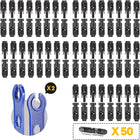What Is the Best Angle for Solar Panels?

Source: YouTube
If you've ever wondered about maximizing your solar panel efficiency, you're in the right place. Today, we're diving into what might seem like a small detail but is actually a big deal in the world of solar energy: the angle of your solar panels.
Keep reading as we take a closer look at the science behind it, offer practical tips for finding the optimal solar panel angle, and discuss how different mounting options can impact your setup. By grasping these details, you can boost your solar efficiency and save money along the way!
Let’s get it started!
Why Does the Angle Matter?
You might be asking, "Why should I care about the angle of my solar panels?" Well, the angle at which your panels are installed can significantly impact how much sunlight they capture, and consequently, how much electricity they produce. Think of it like this: if you’re lounging on the beach, you want your chair angled just right to get the best tan, right? The same logic applies here, but instead of a tan, you’re aiming for optimal energy production.
The Science Behind It
The sun's position in the sky changes throughout the year due to the tilt of the Earth's axis. During summer, the sun is higher in the sky, and during winter, it's lower. Because of this, the angle of your solar panels should ideally change with the seasons.
But let's be real—most of us aren't going to climb up to our roofs or RV tops four times a year to adjust them. So, what's the best compromise?
Finding the Optimal Fixed Angle

Source: BougeRV 41in adjustable mount brackets
For those of us who prefer a set-it-and-forget-it approach, there’s a sweet spot to aim for. The general rule of thumb for finding the best angle is to set your solar panels at an angle that equals your latitude. For example, if you live in Los Angeles, which sits at about 34 degrees north, you'd want to tilt your solar panels to approximately 34 degrees.
But wait, there’s more! If you really want to squeeze out every last bit of efficiency, you can tweak this angle a little:
- Winter: Add 15° to your latitude angle.
- Summer: Subtract 15° from your latitude angle.
So, for Los Angeles, that would be roughly 49 degrees in the winter and 19 degrees in the summer. However, most people find sticking to their latitude works well enough year-round.
Seasonal Adjustment Tips
If you're one of the go-getters who doesn’t mind a bit of rooftop tinkering, adjusting your solar panels twice a year can indeed make a noticeable difference in your solar yield. Here are some tips:
-
Safety First: Always prioritize safety. Make sure you have secure footing and the right tools before attempting any adjustments.
-
Keep Track of Angles: Use a protractor or a digital angle finder to ensure accuracy.
-
Mind the Weather: Choose a clear, calm day for adjustments to avoid any wind-related mishaps.
Considering Roof Design
Not all rooftops are created equal. Your roof's slope and direction (azimuth) play crucial roles in determining the best angle for your solar panels. Ideally, you want a south-facing roof with a pitch that's already close to your optimal angle. But again, don’t sweat it too much if your roof isn’t perfect. West-facing solar panels, for example, can still work wonders, especially if peak energy usage in your household occurs in the late afternoon.
Adjustable Mounts vs. Fixed Mounts

Source: BougeRV 41in adjustable mount brackets
When planning your solar installation, you might come across different mounting options:
-
Fixed Mounts: These are stationary and generally cheaper. They’re set at one angle year-round, typically optimized for your geographic location.
-
Adjustable Mounts: These allow you to change the angle seasonally. While they offer better efficiency, they also require more upfront investment and maintenance effort.

Tracking Systems
If you're into tech and have some extra cash to spend, solar tracking systems can be a real game-changer for you. These systems automatically adjust the angle of the panels throughout the day to follow the sun’s path. There are two types:
-
Single-axis trackers: These move east to west, following the sun's daily journey.
-
Dual-axis trackers: These adjust both horizontally and vertically, providing the absolute maximum efficiency.
While tracking systems can boost energy production by up to 45%, they come with higher costs and potential maintenance issues. It’s essential to weigh these factors against the expected increase in energy output.
Other Factors to Consider
Local Weather: If you live somewhere with a lot of snow, having flatter angles on your panels can help keep the snow from piling up. On the other hand, if your area gets a lot of rain, steeper angles can be a plus because they let the water run off more easily.
Shade: Ensure that trees or nearby buildings don't cast shadows on your panels during peak sunlight hours.
Maintenance: Regardless of the angle, keep your panels clean and free of debris to maintain efficiency.
Conclusion

Source: BougeRV 41″ solar panel tilt mount bracket
So, what’s the takeaway here? The best angle for your solar panels is primarily determined by your geographic location and specific needs. While setting your solar panels at an angle equivalent to your latitude is a solid start, allowing for minor seasonal adjustments can optimize performance further.
Whether you're a hands-on DIYer or someone who prefers to let the pros handle it, understanding the importance of solar panel angles is key to getting the most bang for your buck. And remember, every bit of tweaking helps when it comes to harnessing the power of the sun.















































































































































































































